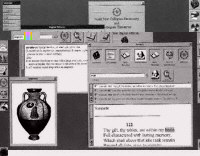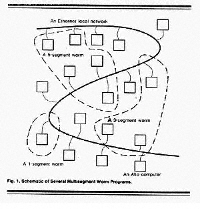|
|


 NeXT
NeXT
|
|
Computers
Apple cofounder Steve Jobs, who left Apple to form his own company, unveiled
the NeXT. The computer he created failed but was recognized as an important
innovation. At a base price of $6,500, the NeXT ran too slowly to be popular.
The significance of the NeXT rested in its place as the first personal computer
to incorporate a drive for an optical storage disk, a built-in digital signal
processor that allowed voice recognition, and object-oriented languages to
simplify programming. The NeXT offered Motorola 68030 microprocessors, 8
megabytes of RAM, and a 256-megabyte read/write optical disk storage.

|
|
|
|
|
Components
Compaq and other PC-clone makers developed enhanced industry standard
architecture -- better than microchannel and retained compatibility with
existing machines. EISA used a 32-bit bus, or a means by which two devices can
communicate. The advanced data-handling features of the EISA made it an
improvement over the 16-bit bus of industry standard architecture. IBM's
competitors developed the EISA as a way to avoid paying a fee to IBM for its
MCA bus.

|
|
|
|
|
People & Pop Culture
Pixar's "Tin Toy" became the first computer-animated film to win an
Academy Award, taking the Oscar for best animated short film. A wind-up toy
first encountering a boisterous baby narrated "Tin Toy." To
illustrate the baby's facial expressions, programmers defined more than 40
facial muscles on the computer controlled by the animator.
Founded in 1986, one of Pixar's primary projects involved a renderer, called
Renderman, the standard for describing 3-D scenes. Renderman describes
objects, light sources, cameras, atmospheric effects, and other information so
that a scene can be rendered on a variety of systems. The company continued on
to other successes, including 1995's "Toy Story," the first
full-length feature film created entirely by computer animation.

|
|
|
 ARPANET worm
ARPANET worm
|
|
Networks
Robert Morris' worm flooded the ARPANET. Then-23-year-old Morris, the son of a
computer security expert for the National Security Agency, sent a
nondestructive worm through the Internet, causing problems for about 6,000 of
the 60,000 hosts linked to the network. A researcher at Lawrence Livermore
National Laboratory in California discovered the worm. "It was like
the Sorcerer's Apprentice," Dennis Maxwell, then a vice president of
SRI, told the Sydney (Australia) Sunday Telegraph at the time. Morris was
sentenced to three years of probation, 400 hours of community service, and a
fine of $10,050.
Morris, who said he was motivated by boredom, programmed the worm to reproduce
itself and computer files and to filter through all the networked computers.
The size of the reproduced files eventually became large enough to fill the
computers' memories, disabling them.

|

|
|

|
|
